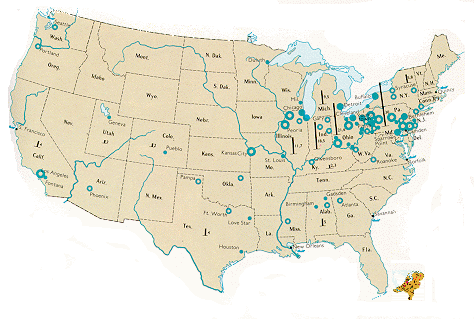
Fig 1: The Netherlands (Yellow)
Steven Pemberton, CWI, Amsterdam
Originally published in ACM SIGCHI Bulletin, Volume 31 Issue 1, Jan. 1999, pp 17–21, https://doi.org/10.1145/329671.329681
The Start
SIGCHI.ROSE
SIGCHI.NL as Non-US Local SIG
Planning the Initial Meeting
The Timetable
Sponsors
The Big Day
The Speakers
Community
Evaluation
Conclusion
Acknowledgments
Since 1985 there has been in the Netherlands a "Workgroup HCI" (in Dutch, werkgroep MCI) a Special Interest Group within the Dutch NGI, active in the Netherlands. This group organised monthly meetings within the Netherlands, as well as a number of conferences.
A number of the active members of MCI were also members of SIGCHI, and in 1993, when CHI 93 / INTERCHI 93 came to Amsterdam, the executive committee of the MCI provided the three co-chairs of the conference (Bert Arnold, Gerrit van der Veer and Ted White).
At the time there was a plan within MCI to start a local SIGCHI SIG, but due to the ACM policy at the time of not allowing 'national' local SIGs, and because of a change of executive committee, the initiative never reached fruition.
In 1995 (not knowing of this earlier plan), three active members of SIGCHI, Eddy Boeve, Hans de Graaff and Steven Pemberton, got together to discuss the possibility of organising a local SIGCHI group in the Netherlands. Despite the existence of MCI, they thought it would be valuable for both SIGCHI and the Netherlands if there were more explicit contact between them: valuable for the Netherlands to have the international contacts, valuable for SIGCHI to have more Dutch involvement.
The three contacted the organisers of MCI and had discussions with them about what they thought of the idea, and the best way to proceed: we didn't want SIGCHI to take over or compete with MCI. The discussions led to the conclusion that SIGCHI and MCI largely addressed different groups in the Netherlands, and the best option was to join forces by merging. (In the event that turned out to be the case: that there was relatively little overlap between people who were involved in MCI and people who were involved with SIGCHI.)
The Netherlands is a small country (see figure 1), about a quarter the area of Florida. We were aware of the (then) ACM regulation that local SIGs should take the name of a city or small region. Unfortunately, there was neither city nor region that reflected the people who would be in the reach of the group. Any name that was based on any existing region or city would mislead people in other regions or cities in to thinking that the group was not addressed to them. In planning discussions we had decided on a town in the heart of the Netherlands, Ede, with good transport and meeting facilities, as being an ideal location for meetings. It is at most an hour's travel for most of the country (see figure 2), only being difficult to reach for one major city (Groningen). Since we would be covering most of the country, we were unanimously of the opinion that SIGCHI Netherlands was the only name that would fairly cover the region. Our only other options were to use a name of a tiny village for instance, that everyone in the Netherlands would recognise as a non-serious name, or a name that Dutch people would recognise for what it meant, but ACM would not, such as SIGCHI Batavia, or SIGCHI IJsselmeer (which we quite liked, since it used the one character special to Dutch "IJ"). It took a long time to persuade ACM of the advantages of naming the group after the region it covered, but eventually after Italy, France and Switzerland joined in with similar requests, they were persuaded.
Once we had a name, events speeded up. In fact we were delighted at how fast we were chartered by ACM after submitting our proposed bylaws. We were chartered in July 1997.

Fig 1: The Netherlands (Yellow)
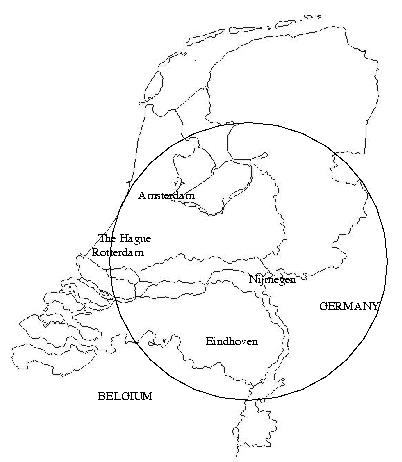
Fig 2: The Envisaged Catchment Area for the Local Group.
The Circle Represents Approximately One Hour's Travel Time
There are a number of problems with starting a local group outside the USA that still have to be properly resolved. The largest is your legal situation. For the ACM your bylaws must be in English. However, to be protected from personal liability in the case of bankruptcy (and, it turns out, to get your own Internet domain name in the Netherlands) you have to be registered as a society, and your bylaws have to be in Dutch. Now we have two sets of bylaws, hopefully not contradictory on any points, but what if they are? Which one takes precedence? Another problem is the financial year. The Sample Bylaws that ACM supplies refers often to the financial year. But ACM has a financial year that starts in July, while the Dutch fiscal year coincides with the physical one.
Our initial plan was to hold a one day conference as kick-off for SIGCHI Netherlands. We based our model on the successful one of the Dutch Unix Users Group, NLUUG, who have been holding successful one day conferences in Ede twice a year for many years. We adopted a similar style, though only a single track conference, and the same or similar prices, f 125 for members, f 195 for non-members (which included membership for a year in the price). We were overly optimistic and planned for the conference in mid-November, but pushed this back to mid-February when we realised we had too much to work out in the time that was available to us as volunteers. Conference centre availability then pushed this back another week.
Luckily one of us (Pemberton) works for the Dutch national research centre for mathematics and computer science, CWI, which has a small conference bureau, since it organises many conferences each year, and they were willing to handle registration for us, and to deal with the conference centre. We agreed to do all publicity and registration electronically, largely to keep costs down.
Since this was a first time, we had no idea how many people would turn up. MCI had some feeling based on earlier conferences they had organised, so we budgeted for 100 people as the break-even point. We agreed to take the (financial) risk of getting an internationally renowned speaker to open the day.
We settled on a theme of "Interaction and the Web" as a current hot topic that would be interesting for a wide proportion of our planned membership. We designed the timetable for the day as starting at 9.30 (we expected most people would be coming by train, and a major train connection arrived at just before 9.15). The day we planned looked like this:
9:00 Registration and coffee
9:30 Introduction
9:45 Opening speaker
10:45 Break
11:15 Lecture
12:00 Lecture
12:45 Lunch
14:00 Lecture
14:45 Break
15:15 Lecture
16:00 Members meeting
16:45 End with drinks
That determined the number of slots we had. So we wrote a call for papers, and with the help of CWI, MCI and ACM, collected as many email addresses as we could and sent it out, asking for submissions as full papers or extended abstracts, in English or Dutch, in HTML.
Our timetable was tight. We posted the call at the beginning of November. We gave authors 6 weeks to submit, and we gave ourselves three weeks to decide which to accept (bearing in mind that Christmas was in that period). We planned to send out a conference announcement in December, and the final program at the beginning of January (we slipped a week with the final program, largely because of the holidays, but otherwise kept to the plan).
We met once a month. Volunteers are largely interrupt-driven, and meetings create milestones for getting things done. One meeting per month proved to be a good interval.
We brainstormed opening speakers, and luckily for us our first choice, Jakob Nielsen, was willing and able to come. He was an excellent choice for several reasons: he originally comes from a small European country (Denmark) so understands something of the culture, he has a long association with SIGCHI (he was on the executive committee from 1993-5) and of course has been involved with hypertext since long before the Web -- he has written several books on the subject, he was currently writing a new book on the subject, he designed the World Cup USA Web site amongst others, and has thought about user interaction and hypertext more than most.
One of us designed a logo (see figure 3), and we set up a Web site on a machine generously provided by the company of one of the organisers. Another employer allowed us to create a mailing list which we used to email the call and announcements.
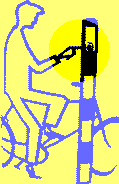
Fig 3: The Interim Logo
In the meantime, the still-existing MCI group had a members meeting and voted to merge with SIGCHI Netherlands on the day of the conference.
We also sent out a call for volunteers, and got a surprisingly good response, and organised a meeting with everyone who responded. The evening of the meeting turned out to be very cold and dangerous to travel on the roads, so those who could turned up, and several others joined the meeting remotely over a chat line, and people at the meeting took it in turns to communicate to the meeting what people were saying, and to type in descriptions of what was happening.
As said, we budgeted a break-even point at 100 attendees. We decided to try and get sponsors for the conference, though we budgeted on the assumption that we wouldn't get any. We had two classes of sponsorship: regular at f 500, and gold at f 5000 ($1 = f 2). We offered regular sponsors their logo on our website, clickable to their website, one free registration, exhibition space at cost (in the end we waived the exhibition costs), their logo on conference materials handed out on the day, and acknowledgement of their support at the opening and closing sessions. A gold sponsor would get two registrations and extra attention paid to them on website, materials and sessions. We had created a simple one-page spreadsheet for the conference (for Pemberton a delight in comparison with the 100-page spreadsheet for CHI 97 which he had recently co-chaired). We created a sponsorship letter and sent it out to all contacts we could think of.
In the end we got ten sponsors! Two of them were 'in-kind', and the rest regular. Though no one took up the gold sponsorship, the sponsors that we did get meant that we were very quickly out of any financial risk area. As registrations began we used the spreadsheet to keep daily track of how much money we had, and adjust our expenses accordingly. It meant we could see that we could afford a beamer rather than just a overhead projector, and that we could afford a thank you dinner after the conference for all the organisers.
On the day of the conference itself, we arrived at the conference centre an hour before time, in order to set up. The area where the breaks and lunch were to be was set up as exhibition space. We had a SIGCHI stall that SIGCHI and ACM had sent materials for, such as copies of the SIGCHI Bulletin and interactions, membership folders, CHI 98 calls for participation, and so on. There were a couple of sponsor companies who had stands, and we had arranged for a bookshop to come, who brought a terrific collection of books that addressed the theme of the conference.
One of us met Jakob Nielsen in Amsterdam and travelled with him in the train to the conference centre ("A real European experience" was his comment).
At 9 o'clock attendees started arriving, welcomed with coffee and cake, and as expected there was a big rush at 9.20. However 200 people turned up! So registration took longer than anticipated, and we started 15 minutes late. However we had planned some slack in the day's timetable so we were able to catch up in the course of the day. As you can imagine, we were over the moon about the turnout. (If the same ratio of US citizens turned up at CHI conferences, it would be twice as big).
We didn't hand much out to the attendees. The papers were going to be published on our website, so we just provided an abstract of the talks, the timetable for the day, a list of attendees, and details of the sponsors.
In the course of the day, we allowed people to deposit their business cards, and then in the afternoon arranged for copies to be made for everyone. We also have them an evaluation form to fill in at the end of the day.
We opened the conference with a welcome where we explained how MCI and SIGCHI NL had merged and what SIGCHI is. And then Jakob Nielsen gave his talk.
He talked on Content Usability, saying that studies he had run had shown that users focus their attention on the information contained in Web pages and pay considerably less attention to navigation elements and graphic decorations, and giving some typical examples of pages where the true content was a tiny proportion of the screen space, the rest being taken up with navigation controls, adverts, and white space.
He showed examples of different styles of writing that are used to present information on websites, and discussed studies into the effectiveness of the different styles in how they get their information over. He showed that the pyramid style of writing as taught to journalists could increase the usability of a website dramatically, but that most sites' web content violated most guidelines for good content. He then went on to discuss the methods companies use to get information on a site, and how these methods are guaranteed to produce unusable content.
The four other speakers represented an extraordinarily good mix both in terms of subject matter as affiliation. One came from a government agency, one from a major bank, one from a research institute, and one from a university. The 4 topics loosely represented the categories Analysis, Design, Research and Evaluation, all with regards to the design of interaction around the Web. The speaker from the bank discussed the principles that went into designing the bank's website. We had designed the slots so that speakers would talk for 30 minutes leaving 15 minutes for discussions, and this talk - maybe not surprisingly - invoked a lot of discussion, which was a good start.
The second speaker was from the Governmental Statistical Bureau, and he presented the design of the search facilities on their website. He described their site as 'content heaven': it is pure content, and users want to find out statistics about certain topics and regions, and so on. The original design had been very technical and so he described how they simplified it. A striking remark he made which will resonate with all HCI people was "when you design a user interface that is as easy to use as a coffee machine, people start treating you like a plumber". (Actually, he should come and see the coffee machine at my work sometime).
The third speaker, from a Dutch University, discussed the user interface aspects of a (non-web) application for control and management of safety on board a ship, and then drew lessons from this that were useful for the design of a website.
The fourth speaker talked about evaluation of an Internet 'booth' for people to access information about local government, and the experiences with user testing.
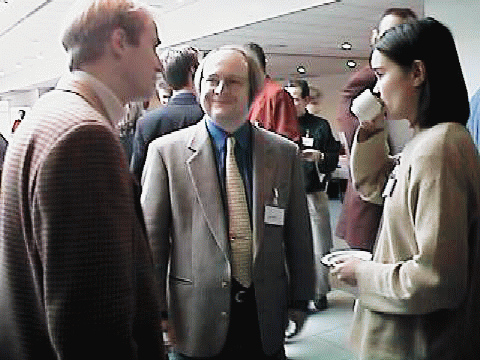
Fig 4: Jakob Nielsen in conversation after his talk
A principal reason for the existence of SIGCHI NL is to create an integrated HCI community in the Netherlands, and therefore people need to meet. Therefore, we deliberately designed for long breaks (borrowing from the successful CHI model). The breaks were in the exhibition hall, where the displays and the bookstall gave reason to move about.
After the lectures, there was a members meeting. This was only 45 minutes long, so it had to happen quickly (there was much positive feedback on this). The members voted on the statutes, the executive committee and its sub-committees (Education and research, Newsletter, PR, Meetings, Website and virtual community, Tele-meetings, Conferences, and North Netherlands - the latter to address the area around Groningen). Finally there was a vote on the name of the group (the winner being SIGCHI.NL), from a shortlist selected from names submitted by members. The submitter of the winning name received a cake as prize.
And then we finished with a reception, again to foster community, and to get a chance to chat with people to find out their impressions of the day. The reactions were overwhelmingly positive, including the remark from one attendee "From today HCI exists in the Netherlands!".
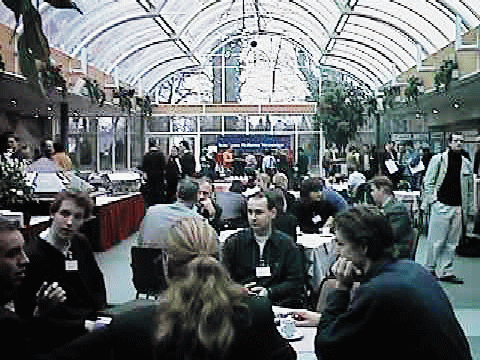
Fig 5: The Exhibition Space
As already mentioned, we had distributed an evaluation form for people to fill in. We expressly asked questions about things that we wanted to know answers about, in order to improve future conferences. We didn't ask, for instance, what people had thought of the speakers: when you select speakers based on a submitted paper, all you can evaluate is the quality of the paper and of the subject matter. Whether the author of a good paper is also a good speaker is purely chance, and so knowing that attendees had valued one speaker and not another would not have given us information that we could use for improving future conferences. On the form, for each question people could circle a number from 1 to 5. The value 1 was the negative value (bad, expensive), or the small value (too few, too short). Below, 0 represents 'no answer'. Sixty-six people filled a form in. These are the results, and an analysis:
0 ( 1): *
2 ( 4): ****
3 (10): **********
4 (41): *****************************************
5 (10): **********
People were generally satisfied. We can be pleased with how the day went.
2 (3): ***
3 (54): ******************************************************
4 (9): *********
Nearly everyone thought the length was right.
2 (9): *********
3 (49): *************************************************
4 (8): ********
Again, most people thought there was the right number of speakers.
1 (2): **
2 (30): ******************************
3 (22): **********************
4 (12): ************
We must do more work on the exhibition.
1 (1): *
2 (3): ***
3 (6): ******
4 (27): ***************************
5 (29): *****************************
The location was nearly perfect.
0 (3): ***
2 (3): ***
3 (26): **************************
4 (18): ******************
5 (16): ****************
The conference was value for money.
Single (43): *******************************************
Parallel (23): ***********************
0 (9): *********
1 (57): *********************************************************
0 (18): ******************
1 (48): ************************************************
0 (33): *********************************
1 (33): *********************************
0 (35): ***********************************
1 (31): *******************************
0 (45): *********************************************
1 (21): *********************
0 (47): ***********************************************
1 (19): *******************
Chat meetings, student presentations.
At the end of the day the organisers went for a meal together to celebrate the day's success. A long time had passed since the first meeting to discuss the possibility of creating a SIGCHI NL local group, but we were pleased that we were meeting our objectives to create a unified group for the Netherlands to address the whole HCI community. The conference had been a success and apparently was a good formula. We had attracted more attendees than we had anticipated, and more people had volunteered to help in the organisation than we had expected. We are looking forward to a fruitful continuation of our initial success.